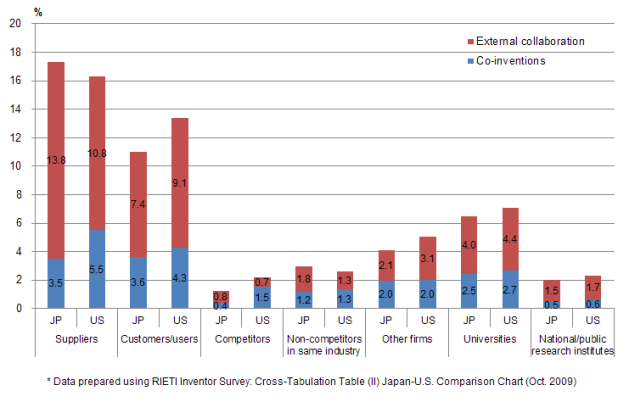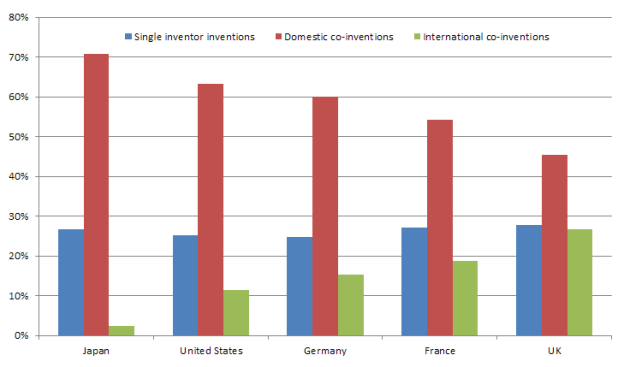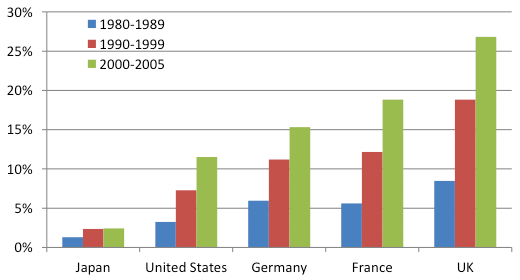Introduction
Innovation in Japan is faltering. According to a research study on science and technology undertaken by the Ministry of Internal Affairs and Communications (MIC), Japan's R&D expenditures peaked at 18.9438 trillion yen in FY2007 and have declined for two consecutive years (Statistics Bureau, MIC, 2010). The number of patent applications has also been on a downtrend in recent years.
This column will compare Japan with the U.S. and three European countries using the results of RIETI's 2007 Inventor Survey and data from patent bibliographic information, and then discuss the extent of openness and globalization in Japan's research and development activities (for details of the Inventor Survey, see Nagaoka and Tsukada (2007)).
External R&D Collaboration: A Japan-U.S. Comparison
Data on joint inventions can also be obtained from patent bibliographic information, but this information only lists those inventors who made substantive contributions to the patented inventions. Recognizing the possibility that other team members also played significant roles in conceiving inventions, however, the Inventor Survey asked in-depth questions about cooperation among researchers in research projects.
The results showed that about 13% of inventions were developed jointly with researchers affiliated with organizations outside the company and regarded as co-inventors during patent application ("co-inventions"). Approximately 28% of inventions involved some form of cooperation with external organizations as partners but not co-inventors ("external collaboration"), meaning that a total of more than 40% of inventions were the products of collaboration with external organizations in one form or another. An Inventor Survey was also conducted in the U.S. using a nearly identical questionnaire; the results of that survey revealed that 12% of U.S. inventions were co- inventions with external organizations and 22% were external collaborations, making in all 34% of inventions produced with collaboration from external organizations. Although it has long been said that Japanese companies show a tendency to be self-reliant in their R&D activities, the above data demonstrate that it is not necessarily the case that Japanese companies on the whole are less likely to seek out external collaboration than their U.S. counterparts when pursuing triadic patents.
Figure 1 presents a breakdown of the organizational affiliations of external collaboration partners (multiple choices of collaboration partners allowed). Both Japan and the U.S. tend to follow a similar pattern, with the largest percentage being collaboration with vertically-related partners (suppliers, customers/users, etc.), followed by collaboration with universities. Collaboration with suppliers is more common in Japan, while collaboration with customers/users, universities and other institutions of higher learning is somewhat more frequent in the U.S.

Walsh and Nagaoka (2009a) analyzes these points in greater detail. Among the findings of that paper are that co-inventions, and in particular co-inventions within vertical relationships, are more characteristic of small and medium-sized enterprises than of large companies and that the frequency of external collaboration varies significantly by area of technology, collaboration with universities being most common in the fields of biotechnology and pharmaceuticals. Estimates made in the paper also suggested that inventions produced in Japan through collaboration, especially vertical collaboration, with organizations of different types were likely to be of high economic value.
External collaboration in R&D thus appears to be a key means of overcoming obstacles to innovation by compensating for insufficiencies in the human resources needed to accurately ascertain technological needs-seeds and to carry out the company's R&D activities.
Globalization of R&D
With production networks becoming increasingly internationalized and with globalization intensifying due to expanded trade, it is only natural that the selection of external R&D collaboration partners would also become international to develop products tailored to local markets. Let us examine the progress of R&D globalization through patent data.
Tsukada and Nagaoka (2010) analyzed co-inventions in Japan, the U.S. and Europe utilizing triadic patent data. Based on information about the number of inventors and their countries of residence, triadic patents were classified into one of three categories: single inventor inventions, co-inventions with inventors residing domestically (domestic co-inventions), and co-inventions with inventors residing abroad (international co-inventions) (Note 1). As apparent in Figure 2, there is not much difference in the ratios of single inventor inventions among Japan, the U.S. and the three European countries examined, but the percentages of domestic co-inventions and international co-inventions (Note 2) differ greatly by country. Figure 3 demonstrates that international co-inventions have been increasing substantially in the four countries other than Japan, while by contrast there has been almost no change at all in Japan's figures. As far as can be ascertained from the patent data, it would seem that globalization has not made deep inroads despite the aforementioned external R&D collaboration being pursued in Japan.


A comparison of Japan and the U.S. also reveals a significant disparity in the number of inventions produced over inventors' life cycles. The cross-sectional data of inventors responding to the Inventor Survey indicate that Japanese inventors begin inventing at a younger age than American inventors (Note 3). The tendency for research to be undertaken at a later age in U.S. companies can be attributed in part to the higher percentage of U.S. researchers with PhDs; in Japan researchers also reach a peak in their research results at a young age (Walsh and Nagaoka (2009b)). One possible explanation for this is that R&D management becomes the prime responsibility of Japanese researchers upon reaching a certain age, leaving them little time for actual research activities. There appears to be an extremely high correlation between the number of researchers involved in R&D projects and the amount of time devoted to research on the one hand, and the quantity and quality of output stemming from these projects on the other (Walsh and Nagaoka (2009a), Tsukada and Nagaoka (2010)). Securing more high-quality researchers is thus an issue of crucial importance.
If a company/country needs to make up a deficit in the human resources available for R&D, then it must seek to actively establish cooperation with personnel outside the company/country. In light of concerns about a long-term shortfall in personnel capable of conducting research in Japan, due partly to the declining birthrate and the aging of the population, Japan's R&D capabilities could perhaps be reinforced over the long term by working to resolve the problem of an extremely small number of female researchers (only about 1.5% of the Inventor Survey respondents were female), making more proactive use of PhD holders in companies, bolstering external collaboration, and establishing a system whereby researchers can engage in invention throughout their careers.


